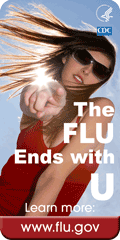 Every fall doctors and nurses talk about getting a flu shot and every year patients have lots of questions about the flu shot. What is it? Do I need it? Who shouldn’t get it? What’s with the nasal vaccine? Should my kids get it? Can it hurt me? So here are some answers!
Every fall doctors and nurses talk about getting a flu shot and every year patients have lots of questions about the flu shot. What is it? Do I need it? Who shouldn’t get it? What’s with the nasal vaccine? Should my kids get it? Can it hurt me? So here are some answers! 1. What is in the Flu Vaccine?
The flu vaccine is a medicine that is very similar to the influenza virus itself. When your body sees gets vaccinated your immune system learns how to fight off viruses that are like those in the vaccine. That way when you get exposed to the flu your body already knows how to handle it and you do not get sick.
2. What about the Swine Flu (H1N1)?
Every year people at the United States Center for Disease Control try to figure out which flu viruses will be the worst and most dangerous. Last year they left one out, the H1N1 swine flu. That is why last year there were 2 different flu shots. This year they included the H1N1 swine flu into the regular seasonal flu vaccine. There are also other strains of flu in this year’s vaccine.
3. What is the Nasal Flu Vaccine (FluMist)?
FluMist is actually a live flu that is changed so that it does not make you sick. It is a nose spray instead of a shot. You must be over age 2 and younger than 49 to get this form of flu vaccine. However, some people should not get this form of vaccine. Kids with asthma, and people with poor immune systems and risk for complications from flu as well as people who have close contact with other people who have poor immune systems.
 4. Who should get it? See list here
4. Who should get it? See list hereOdds are you should get a flu vaccine. The Center for Disease control includes more people every year in the group that should get vaccinated. Everyone who is over 6 months old who does not have a medical reason that they can’t get the vaccine should get it. People who are allergic to eggs can’t get the flu vaccine. Kids getting the flu vaccine for the first time need two doses! Rates of infection are highest among children, but the risks for complications, hospitalizations, and deaths from influenza are higher among persons aged 65 years and older, young children, and persons of any age who have medical conditions that place them at increased risk for complications from influenza.
5. But I got it LAST YEAR!
I know! You have to get it EVERY YEAR. The pesky thing about the flu is it changes every year and so your flu vaccine from last year isn’t protecting you anymore.
6. Should I get it if I am pregnant, breast-feeding or trying to get pregnant?
 YES! It is super important to get the flu vaccine when you are pregnant. For reasons that we don’t understand pregnant women are very susceptible to getting very sick and even dying from the flu. It makes many women nervous to get vaccines if they are pregnant but, there is no evidence that the vaccine hurts the baby. In fact, not getting can result in harm to both mother and fetus!
YES! It is super important to get the flu vaccine when you are pregnant. For reasons that we don’t understand pregnant women are very susceptible to getting very sick and even dying from the flu. It makes many women nervous to get vaccines if they are pregnant but, there is no evidence that the vaccine hurts the baby. In fact, not getting can result in harm to both mother and fetus!7. What happens if I don’t get it?
If you do not get vaccinated there is a higher risk of getting flu and of having complications from the flu. The flu can cause serious medical problems and death. These include bacterial pneumonia, ear infections, sinus infections, dehydration, and worsening of chronic medical conditions, such as congestive heart failure, asthma, or diabetes.
8. Are there risks associated with getting the flu vaccine? Here's safety information from the CDC There are risks to the flu vaccine. There is a rare neurological problem called Guillain-Barré syndrome, which about 1 in 100,000 people will get with the flu vaccine.
9. Who is contraindicated to get this? People with egg allergies; infants under 6 months; individuals who got Guillain Barre (neurologic disease) within six weeks of getting immunized; moderate or severe infection (with/without fever) People in this last category need to resolve their infection before they get immunized.
SO WHERE DO I GET IT? There are flu shots all over, if you have a doctor, call your doctor to ask abour flu shots. You may also be able to get one at work or school. They have flu shots in grocery stores and pharmacies as well!
There are flu shots all over, if you have a doctor, call your doctor to ask abour flu shots. You may also be able to get one at work or school. They have flu shots in grocery stores and pharmacies as well!
SO WHERE DO I GET IT?
 There are flu shots all over, if you have a doctor, call your doctor to ask abour flu shots. You may also be able to get one at work or school. They have flu shots in grocery stores and pharmacies as well!
There are flu shots all over, if you have a doctor, call your doctor to ask abour flu shots. You may also be able to get one at work or school. They have flu shots in grocery stores and pharmacies as well!So go get your flu shot….And Remember ….
For more information on the flu vaccine and immunization try:















